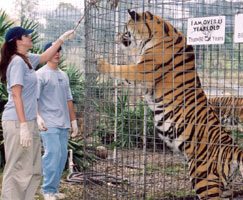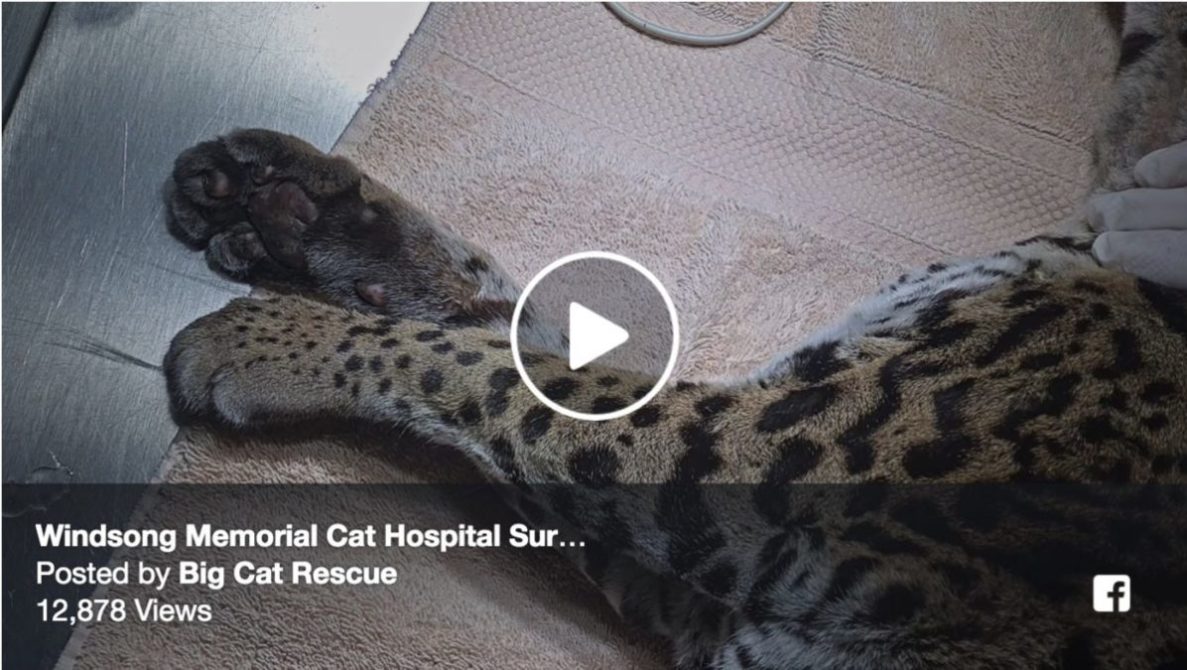Operant Conditioning Video
Operant Conditioning Video

Operant Conditioning: Big Cat Rescue’s Animal Training Program is based on operant conditioning and clicker training techniques. Operant conditioning is a type of learning in which behaviors are altered by the consequences that follow them. The behaviors are not forced, but “caught”, reinforced and therefore trained. We train only natural behaviors, no entertainment types of behaviors.
Clicker Training: Clicker training is a positive-reinforcement training system. It is based on the principle of operant conditioning. It incorporates the use of a Bridge (the click) to tell the animal precisely what it was doing right at that point in time. Behaviors that are marked by the click, and therefore reinforced, are more likely to happen again. Animals learn very quickly that click equals treat. The trainer “clicks” (marks the desired behavior) and then gives the animal a piece of favorite food or another reward for which the animal will work. It is crucial that the click be followed immediately by a treat. The sound of the click becomes associated with a positive reward.
Animal care managers all over North America are discovering that well planned animal behavior management programs featuring operant conditioning can:
-
Reduce the stress loads imposed by captivity
-
Enhance keeper safety
-
Facilitate routine care
-
Improve animal welfare
-
Enrich the volunteer experience
Big Cat Rescue’s Animal Training Program is intended for:
-
Eliciting calm behavior from each of our animals while they are in the presence of their keepers and veterinary staff
-
Training behaviors that are dependable regardless of the trainer present
-
Providing mental stimulation for our animals
-
Enabling safe emergency and non-emergency transportation of the animals
-
Providing public education
Levels of Training: Big Cat Rescue’s Animal Training Program is broken into 4 levels. These levels refer to the type of training being taught and the level at which the animal and or trainer has reached in their training. Volunteers are evaluated by the Operant Committee and approved for training specific levels of behaviors. Yellow Level Keepers and Level 1 Interns participate in Level 1 & 2 Operant Training with Small Cats (excluding lynx and quarantine). Green Level Keepers participate in Level 3 Operant Training with Small Cats and Level 1-3 Operant Training with Big Cats that they are certified to clean (ie. quarantine, Reno, and Cheetaro). Master Keepers and Coordinators participate in Level 4 Operant Training with all cats.
LEVEL 1: Click and Treat – Fishing for Cats
In this level the trainer will be:
-
Working with the animals that are more timid and are very new to the training program
-
Desensitizing the animals to the operant conditioning stick
-
Introducing the animals to the click (bridge)
-
Learning timing of the click and reward
The purpose of Click and Treat is to build rapport and trust with the cats and learn timing of the treat and your ability to read the cat.
Criteria for animal to advance to Level 2: To have the animal consistently come to a spot at the side of the cage where the trainer is located, and remain throughout the training session.
Criteria for volunteer to advance to Level 2:
-
Learn how to click and treat (C/T).
• Do not point the clicker at the animal.
• Reduce the amount of movement that you make when clicking.
• Let the click speak for itself – no additional praise.
• Click during the move, not after.
• Click should be before the treat is taken.
• Click and treat 10 times.
-
Put treats on the end of the operant conditioning stick and put the end of the stick into the cage.
-
Click BEFORE the animal takes the treat off of the stick, NOT AFTER.
-
Training will be done at the side of the cage near the lockout.
-
The volunteer must consistently deliver the correct timing of the click and the treat for the correct behavior. Cat is at side of cage all feet on ground, head inside cage.
LEVEL 2: Hand Signals and Behaviors
In this level, the trainers will be:
-
Working with animals that are familiar with the bridge and operant conditioning stick.
-
Using verbal and/or hand signals (commands) for desired behaviors.
-
Working on the following behaviors:
• Lockout
• Down
• Up
• Sit – this one is a bonus behavior, not required for cat to move to level 3
-
Working in pairs whenever possible to acclimate animals to multiple keepers being present.
LEVEL 3: Advanced Behaviors and Training Volunteers
Senior Keepers and Master Keepers participate in Level 3 training. Level 3 training includes; training and observing Level 1 and 2 trainers, fine-tuning behaviors that animals learned in Level 1 and 2, and advanced behaviors; right/left, open mouth, right/left paw, closing animals in lock out.
LEVEL 4: Veterinary Care Training
Master Keepers and veterinarians participate in Level 4 training. Level 4 training includes; working with animals in the cat hospital or in quarantine, desensitizing animals to topical sprays, training target behaviors for specific veterinary procedures, working with veterinary care staff, training and observing Level 1, 2, and 3 trainers, and evaluating the animals and trainers progress.
General Guidelines:
-
Trainers will only be working at or below their approved level of training.
-
Always check with the Coordinator prior to planning a session.
-
Training sessions should be well planned out before starting.
-
Training sessions will be logged on the Operant site on the .me site
-
Training sessions should be short.
-
If an animal acts aggressively towards any trainer it is the trainer’s responsibility to discontinue working with that animal and to report the incident to the Coordinator.
-
Use only approved verbal and hand signals.
-
“No” is never to be used during training sessions. Never draw attention to errors. Ignore what you don’t want. Reward what you do want.
-
If the animal is not cooperating step back and reset then resume training session. Do not repeat commands. Say it once and be patient.
-
Training sessions should be with a partner as often as possible. This will allow the animals to be accustomed to more than one person during the training sessions. This will also allow the other person to observe and to give their input on the session.
-
If there is more than one animal in a cage, two trainers must be present or the animals must be separated without causing stress.
-
Training sessions should take place when the environmental conditions are most favorable. Training sessions are not recommended in the rain or heat of the day.
-
Avoid food reinforcement immediately after feeding time. However, it would be optimal shortly before feeding.
-
Anytime we are feeding, interacting, cleaning, giving tours, etc we need to keep in mind that we are affecting how that animal interacts with us. Do not ever reward/reinforce bad behaviors.
-
We will need to work as a team for this program to work. Everyone will get to train animals they really like, but we need to make sure that the animals’ needs come before our needs.
-
Advancement to the next Level of training for animals and trainers will be decided after an
-
evaluation by the Operant Committee.
-
A master chart indicating each animal’s and trainer’s level of training will be maintained by the Operant Committee and will be posted on the Operant .me site.
-
Do not use the clicker to call the cat.
Training Program: Ideally we would like to have all animals and eligible keepers participating and helping us achieve the goal of the Operant Training program. That goal is to make feeding and caring for the animals including observations, medical exams, and vet procedures as safe and efficient as possible. This program is designed with the animals’ and sanctuary’s needs in mind. This is a very strict program that requires a lot of dedication and work to ensure success. Trainers should be prepared to commit a minimum of 2 days per week to participating in this program.
OPERANT CONDITIONING COMMANDS FOR LEVEL 1 & 2
Please use only the commands listed below. These are the approved commands that we will need for general husbandry. As the animals progress, additional commands and behaviors will be added.
LEVEL 1
Click and Treat – Animal: Animal comes to the side of the cage and takes reward off the stick without swatting, stick biting, or any part of their body out of the cage. Trainer: Trainer will use operant stick to deliver reward, clicking before the cat takes the reward. Make sure timing is such that cat is not getting anxious or walking away.
LEVEL 2
DOWN – Animal: Animal should have all 4 feet on the ground inside the cage, crouched so belly and chest is on the ground. Animal should be sternal and facing Trainer. Trainer: Verbal command “down” simultaneous with flat palm moving down. At the same time the trainer drops to one knee. Fingers should be closed, as with all hand signals hand should be well away from the cage and the reach of the cat.
UP – Animal: Animal should have back feet on the ground, front feet preferably flat on the side of the cage. Animal should not be reaching out or swatting at stick. Trainer: Verbal command simultaneous with palm facing up and raising palm appropriate to the height of the animal. (We don’t want the animal climbing the cage or having all 4 feet on the cage wire) Fingers should be closed together, as with all hand signals hand should be well away from the cage and the reach of the cat.
LOCKOUT – Animal: Animal should have all 4 feet in the lockout and remain until given several treats or another command. (Running in and grabbing a treat and running out is progress towards but not considered lockout) Trainer: Verbal command given while pointing to or walking towards lockout
SIT – Animal: Butt on the ground, front legs straight, both front paws on the ground facing the trainer. Trainer: Verbal command simultaneous with Open palm facing animal, i.e. stop signal. As with all hand signals hand should be well away from the cage and the reach of the cat.





Great video for training your cats at home too.